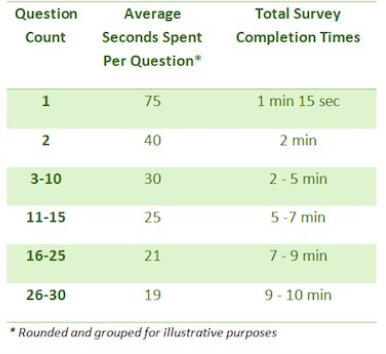

We probably don’t need to tell you how important patient feedback is for your practice (well, actually, we already told you: Why Feedback is Important for Your Practice (and How to Collect it)).
And it’s not enough to just ask for an online review. Although most patients do perform a quick Google search when looking for a new medical group or specialist, an ambiguous star-rating likely won’t give you the insight you need to advance your practice.
That’s why it’s so beneficial when patients complete a survey after their visit.
Patient surveys can help identify areas of improvement, gaps in care, and opportunities, while also reinforcing things your practice is doing right and helping to engage your patients—all of which positively impacts your bottom line.
That’s all well and good, but how do you make sure your survey is effective—both in achieving a decent completion rate and giving you the insight you need?
You need to be thoughtful about what you ask in your patient survey and how you deliver it, which is why we’ve taken the time to teach you how to create the perfect patient survey.
You obviously want to get the most honest and thorough feedback you can from your patients, but you also don’t want inundate them with a long list of questions or ask them things that are complex in nature.
People are more apt to complete a survey if they are given a heads up about how long it will take, and the shorter the better. It’s not that they aren’t willing to help your practice, but rather they aren’t looking to take a chunk out of their day to do so.
It’s ideal to keep your patient satisfaction survey under five minutes, which means trying to keep your survey to 10 questions in total.

Source: blog.hubspot.com
That’s why you need to make every question count, which brings us to…
First, establish the goals of your survey. Though we’re sure the overall idea is to improve patient satisfaction, try to dig a little deeper to identify the areas you’d like to learn about.
Is appointment scheduling easy? How was the patient’s experience with your front office staff? Do they appreciate being able to fill out forms electronically? How likely would it be for them to recommend your practice to a friend?
If there are certain aspects of your practice that you’d like some insight into, or want to know if a technology or marketing investment was worth the money, then make sure you have questions directed at each of those things.
Once you understand the goals of your survey, it should be easier to pare down the types of questions you want to ask. Remember, you really should be keeping the total amount to 10 or fewer, so it’s important to maximize the questions you do have to make sure you are covering your areas of need.
In some capacity, your survey should include questions from these three categories:
You’ll likely want to include a couple questions around how convenient your practice is for a patient.
Convenience isn’t just about the distance from a patient’s house to the office (because obviously you have no control over that), but more about:
– Scheduling appointments: Do you offer online appointment booking? Are you available to patients?
– Rescheduling appointments: Can this be done online? Is your front office staff efficient at manning the phones and calendar?
– Wait times: How long does a patient typically have to wait in your waiting room before being seen? Does your practice tend to stick closely to the day’s schedule? (Pro tip: Offering electronic intake forms through IntakeQ can significantly cut down on time spent in the waiting room, which helps get patients in and out faster, thus avoiding appointment times being pushed back.)

Be sure to include some questions about the quality of care the patient received, which after all is arguably the most important part of your practice.
This could include questions about:
– Physician or specialist: How was the practitioner’s bedside manner? Did he/she spend an appropriate amount of time with the patient? Does the patient feel as though his/her questions were answered?
– Nurse practitioner or technician: Did the professional provide ample explanation of any tests or services? Did he/she make the patient feel comfortable?
– Technology: Does the patient feel that your practice uses the most up-to-date equipment and follows advancements in the medical industry?
Aside from handling appointments and seeing the practitioner, there are other factors that play into a patient’s overall satisfaction. These can include:
– Front office staff: Did the patient have a pleasant experience with your staff? Were they greeted warmly, given an estimated wait time, and treated with respect?
– Communication: Does your practice utilize an appropriate reminder system? Were any changes of an appointment properly communicated in a timely manner?
– Cleanliness: Were your waiting room and exam/treatment rooms clean and comfortable?
We mean this in a thoughtful and purposeful way, of course. By mixing things up, we’re talking about using the question form that best suits the question.
In some cases, this could be using multiple choice answers or a numerical scale (e.g. “From one to five, with five being most likely, how likely are you to recommend our practice to a friend?”).
In other instances, open-ended questions make the most sense. This is particularly true when asking for additional comments or specific details around how your practice could improve.
In order to decipher which method is best for each question, consider working backwards. What kind of answer are you looking for from the patient? From there, it’s easier to identify what type of question you should be using.
You may have your questions nailed down, but how do you get them to the patient? Do you have them fill our a questionnaire following their appointment? Send them an email post-visit?
We definitely recommend against having a patient fill out a form at the office—not only does this add to their time spent at an appointment, but it may make the patient feel uncomfortable.
It’s much better to deliver a survey electronically once they have left your office. This allows the patient to complete the survey at a time that is most convenient for them and allows them the space to think more critically about their answers.
That’s where we come in.
IntakeQ allows you to easily gather data from patients, whether through the secure patient portal or via email. Through our system, you can chose to make questionnaires anonymous, which are great for surveys and polls (after all, patients are more likely to be honest in their feedback if they aren’t worried about hurting a relationship or retaliation).
Free Download: 6 Common Survey Mistakes
Sending a patient satisfaction survey isn’t just valuable in collecting feedback – it’s also another way to show your patients how much you prioritize their experience.
The seemingly simple oversight of NOT providing patients with a survey can hurt your practice. It may be perceived as not caring about the patient’s opinions or being unwilling to take the time to improve your practice.
By following the advice above and taking the time to build out a survey that best fits the needs of both your practice and your patients, you’ll be poised to gather helpful insights that can help your practice grow and thrive.